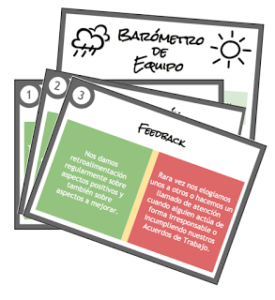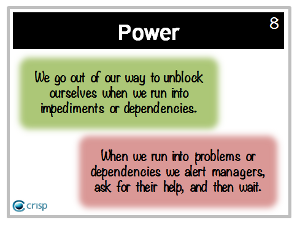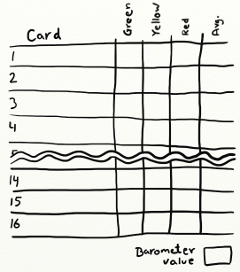Sometimes it’s hard for a team to know if they get tighter and better as a team over time. This is a tool that allows a team to learn just that.
Team barometer (self-evaluation tool) in a nutshell
The barometer is executed as a survey in a workshop. The survey consists of 16 team characteristics, packaged as a deck of cards. Team members vote green, yellow or red for each card in the meeting (or before the meeting as an anonymous survey). Once all cards have been run through, the team reflects and discusses the results. You can, if you want to, run through the exercise in thirty minutes, but I recommend to set aside an hour.
Click here to download the cards.
 Damián Buonamico has translated the cards to Spanish. Damián Buonamico has translated the cards to Spanish.He has also created a version 2.0 with some additional questions. Check it out here. |
Background
I’ve developed this exercise for two reasons; to evaluate how/if the team gets stronger over time, and as a teambuilding alternative to action oriented retrospectives.
There are many ways a team can create feedback loops that tell them how good they are at delivering (lead times, velocity, feature vs failure demand ratio, customer feedback, etc.) but it is quite tricky to measure how well a team is working together. It’s easy to increase delivery by for example working overtime, but that doesn’t mean that the team is more efficient as a team.

Most retrospectives are focused on how we can solve problems we are having, or which improvements to work on next. This is of course great, we want to improve our process and our tools. But it is equally important to spend time and energy to discuss the team itself so that members build trusts and gels as a team.
The inspiration to the cards, and the statements on the cards, are from all over the place. These are some sources: Five Dysfunctions of a Team (Patrick M. Lencioni), Teamwork is and Individual Skill (Christopher Avery), Squad Health Check (Spotify), my colleagues at Crisp, and probably many other sources from my years as an agile coach.
Note: I would not run this exercise with a dysfunctional team that struggles to get along. Other kind of work will probably provide much higher impact and help the team to get on the right track faster (such as working on defining and uniting around clear goals, discussing and creating a working agreements, defining a process that fits the team’s needs, etc.).
.
Preparations
Download the cards, print them, and cut them out. You want one deck for each participant. Click here to download the cards.
You also need voting cards. One green, one yellow and one red card for each participant. Post-it will do great.
Note: If you are doing it as an anonymous survey you download the survey instead and asks each person to fill it in and bring it to you before the workshop or retrospective. Click here to download the survey.
If you want to create your own cards, or customize them, you can find a full list of the cards in the appendix at the end.
.
Running the survey
Explain the purpose of the survey and that we can, if we want to, repeat it a couple of months into the future.
 Draw a table on a whiteboard. One row per card. Five columns. Sixteen rows. See illustration to the right. As you go through the cards write down the name of the card as the cards are being drawn and voted upon.
Draw a table on a whiteboard. One row per card. Five columns. Sixteen rows. See illustration to the right. As you go through the cards write down the name of the card as the cards are being drawn and voted upon.
Each card has a headline naming a characteristic of a team, and a green and a red statement. Read them out loud. Give people a couple of seconds to think. Then ask them to choose one of the voting cards. Green means that you agree with the green statement, red that you agree with the red statement. A yellow vote means that you think it’s neither green nor red but something in the middle.
At a count to three everyone reveals their vote simultaneously. Count the votes and add them to the table on the whiteboard.
 If someone feels the want to discuss the votes, tell them that we first do the survey and once all cards have been voted on we continue to the next step in the exercise, which will include discussions. Tell the group that the can put aside the cards as reminder so they don’t forget to raise them for discussion later.
If someone feels the want to discuss the votes, tell them that we first do the survey and once all cards have been voted on we continue to the next step in the exercise, which will include discussions. Tell the group that the can put aside the cards as reminder so they don’t forget to raise them for discussion later.
Once you have dotted down the votes on the whiteboard, proceed with the next question.
It shouldn’t take longer than 15-20 minutes to run through the cards, unless of course you choose to allow discussions after each card.
.
Reflect and summarize
Note: If you did the survey anonymously this is where the meeting starts. Draw the table along with the votes before participants enter the room.
Before proceeding to the discussions, do a factual summary of the results. Ask people to summarize what they see. Where is the voting concurrent? Where is there a lot of green? A lot of red? Where are the votes spread all over the green-yellow-red scale? It’s much better if the participants can describe this since the insights will be theirs.
Wrap up the summary by calculating the barometer value. Green = 2, Yellow = 1, and Red = 0. Write down the average for each row. Sum all the rows together and fill in the sum in the “Barometer value” square.
.
Discussion
One way to start this is to simply ask – what do we need to talk about? What do you want to share?
This is all play by ear. You will never be able to anticipate which discussions that might arise. The cards cover a broad spectrum and no matter how gelled and strong the team is there will surely be some statements or votes that trigger discussions and debate.
If the team however doesn’t seem to find where to start, and silence from your part doesn’t cut it, you could ask if anyone wants to clarify their vote somewhere or if anyone has put aside a card that they wanted to discuss after the voting.
Don’t feel pushed to facilitate the discussions so that they end in actions. These kind of topics are more about trust, feelings and motivation and aren’t always actionable. Just having the discussion can be valuable enough and have strong long-term impact on behaviour and the team’s ability to collaborate.
As an ending, ask the team if they would like to do a follow up in the future. If they do, ask how far into the future. If not, end the meeting and thank people for attending and trying out the exercise.
.
Follow up
If the team wants to, schedule an invite immediately after the meeting so that it is done and you can forget about it. Make sure you document the outcome and the barometer value of the meeting. The simplest approach is probably to take a photo of the whiteboard and put in on the wiki (or mail it out to the team).
.
Alternatives
Fewer cards – more discussion
If you feel you want plenty of time to discuss after each voting you might want to reduce the number of cards to five or six. Choose the one that you might think reflects the teams own values and desires best, or choose the cards that you think will spur the most interesting discussions.
Perfection game – action oriented
To turn the retrospective into a more action oriented exercise you could choose only three cards. Replace the red-yellow-green voting with a perfection game where each member places a vote on a scale 1 (red) to 10 (green) along with comments on post-its that describes what that person needs or wants to happen in order to turn his or her vote to a 10. Boil down the comments and suggestion to a couple of actionable items, prioritize them and assign action points to volunteers.
.
Final note
This selection of cards, and the statements written, on them is a snapshot how I ran the exercise the last time. Every time I use them I tend to review them and fiddle around with both the number of cards and the statements written on them. I suspect that I in the future will have learned which cards spurs the best dialog and manage to reduce them to fewer than 16. I might go back and update the materials presented here, I might not.
Good luck!
.
Appendix
| # | Card | Green | Red |
| 1 | Trust | We have the courage to be honest with each other. We don’t hesitate to engage in constructive conflicts. | Members rarely speak their mind. We avoid conflicts. Discussions are tentative and polite. |
| 2 | Collaboration | The team cross-pollinates, sharing perspectives, context and innovations with other teams, and other parts of the organization. | Work is done individually. Little or no collaboration within the team or with other teams. |
| 3 | Feedback | We give positive feedback, but also call out one another’s deficiencies and unproductive behaviors. | We rarely praise each other or give feedback or criticize each other for acting irresponsibly or breaking our Working Agreement. |
| 4 | Meeting Engagement | People are engaged in meetings. They want to be there. Discussions are passionate. | Many feels like prisoners in the meeting. Only a few participate in discussions. |
| 5 | Commitment | We commit to our plans and hold each other accountable for doing our best to reach our goals and execute assigned action points. | We don’t have real consensus about our goals. We don’t really buy in to the plan or follow up that people keep their commitments. |
| 6 | Improving | We passionately strive to figure out how to work better and more efficiently as a team. We try to “know” if we get better. | We don’t focus on questioning our process or way of working. If someone asked us to prove that we’ve gotten better we have no clue how we would demonstrate that. |
| 7 | Mutually Responsible | We feel mutually responsible for achieving our goals. We win and fail as a team. | When we fail we try to figure out who did what wrong. When we succeed we celebrate individuals. If we pay attention to it at all… |
| 8 | Power | We go out of our way to unblock ourselves when we run into impediments or dependencies. | When we run into problems or dependencies we alert managers, ask for their help, and then wait. |
| 9 | Pride | We feel pride in our work and what we accomplish. | We feel ashamed of our pace and the quality of our results. |
| 10 | Relationships | Team members spend time and effort building strong relationships among themselves, as well with partners outside the team. | We don’t really know each other or what makes others “tick”. |
| 11 | Ownership | We engage in defining our own goals and take ownership of our destiny. | We act as pawns in a game of chess. We don’t demand involvement in defining our goals and destiny. |
| 12 | Sharing | We share what we know and learn. No one withholds information that affects the team. | People do stuff under the radar and often forget to share news or relevant information. |
| 13 | Boosts each other | We unleash each other’s passion and care for each other’s personal development. We leverage our differences. | We don’t know in which areas people want to grow. We have trouble collaborating since we are very different and view things differently. |
| 14 | Loyalty | No one has hidden agendas. We feel that everyone’s loyalty is with THIS team. | The team feels like a diverse group of people with different goals and loyalties that lies elsewhere. |
| 15 | Passion | Each member wants THIS team to be great and successful. | People just come to work for 8 hours and focus on their own tasks. |
| 16 | Integrity | We honor our processes and working agreements even when we are put under pressure. | Our behaviors, collaboration and communication fall apart when we get stressed. |





Excellent Tool Jimmy.
In your experience who should be conducting this survey to high effectiveness ?
Can this be initiated by Individual Function Manager of an Organization ?
I think the exercise should be facilitated by the teams Scrum Master, an agile coach, a member from the team, or perhaps another teams Scrum Master.
I don’t see a problem if a salary-setting manager suggests the tool, but if the same conducts the survey I think many teams will suspect that the manager has a hidden agenda, and hence won’t be truthful in their responses or dialog. It might even risk lowering motivation.
It needs to be a tool for the team. The outcome needs to be owned by the team. It’s a tool for the team to learn if they getter over time and to raise discussions within the team regarding expectations, motivation, responsibility and team dynamics.
Hi there! I work for a company specialising in organising team building events. With your permission, I’d like to publish it on our company’s blog, with credits attributed to you of course. You can check out our blog here: http://www.jambarteambuilding.com/blog-2/. Thanks!
Happy you liked the Team Barometer!
No problem re-publishing 🙂 A long as you include credits and a link to the original blog-post.
/Jimmy
Hi Jimmy,
Thanks for writing this. In my company, Multunus Software, we’ve started using it and team is really liking it. Thanks once again.
Leena
Hi Jimmy,
New to these games.
Can you please elaborate on the result of this evaluation??
for example
Green Yellow Red
Trust 1 4 5
Collaboration 0 2 8
Feedback 6 3 1
What will be the barometer value?
Hi Prashant,
I guess the value would be:
Trust: 1×2 + 4×1 + 5×0 = 6
Collaboration: 0x2 + 2×1 + 8×0 = 2
Feedback: 6×2 + 3×1 + 1×0 = 15
6 + 2 + 15 = 23
But the actual barometer value isn’t what is important. Don’t focus on that. What is important is the discussions that arise after the voting has taken place.
Best Regards
/Jimmy
Thanks for answering Jimmy as well for this wonderful article 🙂
Thanks for the great post. I have gone through your blogs listed in the website. The fun activities really impressed me and am eagerly waiting for such an opportunity in my environment
Hi Jimmy,
This is great stuff. I highly relate to the questions. Was in the process of building something similar for a client but I think I will start with your great work (will refer to the original blog post of course). If I end up modifying it I will share alike here as well as post on my blog and link back here.
Yuval
Thank you very much for this article. Team barometer is exactly what I was searching for! We discussed its application at our company and we got an idea to change the voting options a little bit. We are a bit afraid that team members will always vote “yellow” because usually nothing is completely perfect or completely wrong. So our suggestion is to use 4 options:
* green (totally agree) – 3 points
* yellow-green (rather agree) – 2 points
* yellow-red (rather disagree) – 1 point
* red (disagree) – 0 point
Can you provide me with your opinion on this change? Do you see any disadvantages, obstacles or anything? Do you have experience with different types of voting ranges?
Thank you.
Regards,
Martina
Hi Martina,
Really sorry for this slow reply. Happy to hear you like the team barometer. I definetly think your approach is worth trying and I think you have a point. I have however not really felt this has been a problem because when you combine the votes of the group you see patterns even to each individual only has three options. But having a scale with four options might force people to think a little bit harder. Sounds definetly like it’s worth a try!
Good luck 🙂
/Jimmy
Hi Jimmy Janlén,
Thanks for the article you have written and i read it with great interest. Can i share it on my linked in page our on my website http://www.tvworkshop.com/.
Please let me know!
With regards,
Emile Leus
If you want to write a few lines about the tool, and then share a link to this blog – go ahead 🙂
/Jimmy
Hi Jimmy,
Thanks for your great article. Can i use it for our team building events for TVworkshop Asia http://www.tvworkshop.com/
Hope to hear from you soon.
With regards,
Emile Leus
Hi Emile,
What do you mean with using it? If you mean run it as a workshop? Then of course 🙂
Otherwise please elaborate. If you want to you can mail me at jimmy.janlen@gmai.com.
Cheers
/Jimmy
Hi Jimmy,
This is really good. Like the option of anonymous survey to help teams that are not comfortable in opening up. Curios to understand the the use of Barometer value. Is it to look if the trend is improving or decreasing over a period of time?
Thanks,
Sandy
Hi Sandy,
Yes. If you intend to do a follow up in the future the sum could be interesting to record. But I do believe the true value rises from the discussions that the cards trigger is the most important. I wouldn’t focus on the Barometer Value at all actually. I would focus on the dialog and the ideas for change that they trigger.
Kind Regards
/Jimmy
Hello Jimmy, surfing this article i found that the spanish translation has linked incorrectly
The correct link is: http://www.caminoagil.com/2016/11/02/barometro-de-equipo-descarga-las-tarjetas-en-espanol/
Thank’s a lot for this technique, i’ll using it the next week via anonimous sourvey, we’re just starting with agile!
Hello Jimmy,
I was just looking for a survey like this to evaluate the team’s motivation and situation. This is a really detailed and well-prepared work. Thanks for sharing with us.
I’ll definetely try for our agile teams.
Kind Regards,
Ece
hello jimmy,
a very exciting tool, will use it in my department for sure.
lets see what would be the response from team
What to conclude on the Barometer score, meaning which value is good or bad? For our team its 15. Would like to understand and know what would be next step based on this value, other than discussing improvements on each value.
No single data point is good or bad. My opinion is that the conversations the exercise trigger, the generated insights and agreements on improvements – those are the thing of value.
If you repeat the exercise over time however (perhaps every 6th month) then most likeley the trend and changes in the scoring will generate new discussions and insights.
Benzne helps them to adopt a quick, time-bound, outcome-driven Agile and DevOps led transformation journey marrying culture, mindset, process, tools, and hands-on implementation expertise.